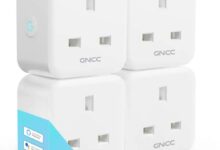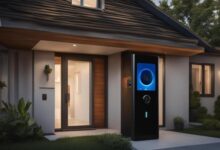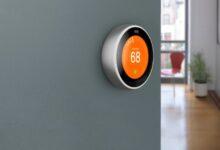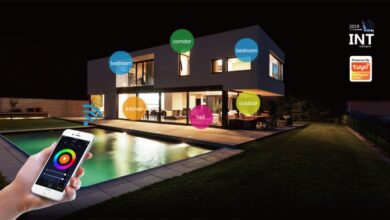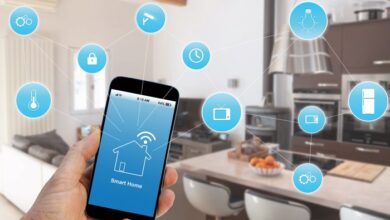Smart Door Locks A Comprehensive Guide
Smart Door Locks: Step into a world of enhanced security and unparalleled convenience. Forget fumbling with keys – we’re diving deep into the technology, exploring different types, security features, integration possibilities, and future trends. This isn’t just about upgrading your locks; it’s about upgrading your entire home security strategy. We’ll uncover the best practices for setup, maintenance, and troubleshooting, ensuring you’re fully equipped to navigate the exciting landscape of smart home security.
From keypad entry to fingerprint scanning and sophisticated Wi-Fi connectivity, smart locks offer a range of options to suit every lifestyle and security need. We’ll analyze the pros and cons of each type, examining their vulnerabilities and highlighting essential security measures to protect your home. Think of this as your ultimate handbook for navigating the world of smart locks, empowering you to make informed decisions and maximize your home’s safety.
Types of Smart Door Locks
Smart door locks represent a significant leap forward in home security and convenience, offering a range of features and functionalities beyond traditional key-based systems. The market is diverse, with various mechanisms catering to different needs and budgets. Understanding the differences between these types is crucial for making an informed decision that best suits your home’s security requirements and your personal preferences.
Choosing the right smart lock involves considering factors such as installation complexity, security features, and budget.
Smart Lock Mechanisms
Smart locks utilize a variety of mechanisms to grant access, each with its own strengths and weaknesses. Keypad locks offer a simple, code-based entry system, while fingerprint locks provide a biometric approach. Bluetooth locks utilize short-range wireless technology for convenient access from nearby smartphones, and Wi-Fi locks offer remote control and integration with smart home ecosystems. Each method provides a different level of security and user experience.
Security Features Comparison
The security of different smart lock types varies considerably. Keypad locks are susceptible to brute-force attacks if weak codes are used, while fingerprint locks can be vulnerable to spoofing techniques if the sensor is not high-quality. Bluetooth locks are generally secure when paired with strong passwords and up-to-date software, but their limited range can be a drawback. Wi-Fi locks, while offering remote access, are potentially more vulnerable to hacking if not properly secured and updated.
Multi-factor authentication, tamper alerts, and robust encryption protocols are key security considerations across all types. For instance, a system that requires both a PIN and a fingerprint offers significantly enhanced security compared to a system relying solely on a PIN.
Smart Lock Installation Processes
Installation processes vary depending on the type of smart lock and the existing door hardware. Keypad locks often require replacing the existing deadbolt, while others can be installed over the existing mechanism. Fingerprint locks typically involve more intricate installation procedures, often requiring precise alignment and calibration. Bluetooth and Wi-Fi locks frequently require integration with a home’s existing network, demanding a basic understanding of networking and potentially professional assistance for complex setups.
Generally, basic mechanical skills and access to standard tools like screwdrivers are sufficient for many installations; however, more complex installations might require professional locksmith services. Always refer to the manufacturer’s instructions for detailed guidance.
Smart Lock Brand Comparison
The market offers a wide range of smart lock brands, each with varying price points, features, and security levels. Consider the following table as a comparative guide; remember that prices and features can change.
| Brand | Price Range (USD) | Key Features | Security Level |
|---|---|---|---|
| August | $150 – $300 | Bluetooth, Wi-Fi, Keypad, Remote Access, Smart Home Integration | High (depending on chosen model and security protocols) |
| Schlage | $100 – $350 | Keypad, Bluetooth, Z-Wave, Remote Access, Various Keypad and Deadbolt Combinations | High (depending on chosen model and security protocols) |
| Yale | $120 – $400 | Keypad, Fingerprint, Bluetooth, Wi-Fi, Smart Home Integration, Keypad Backlit Options | High (depending on chosen model and security protocols) |
| Kwikset | $80 – $250 | Keypad, Bluetooth, Z-Wave, SmartKey Technology | Medium to High (depending on chosen model and security protocols) |
Smart Lock Security and Privacy
The convenience of smart locks is undeniable, but their security and privacy implications are crucial considerations for any homeowner or business owner. A compromised smart lock can lead to significant financial and personal losses, highlighting the need for a proactive and multi-layered security approach. Understanding potential vulnerabilities and implementing robust security measures is paramount to ensuring the safe and reliable operation of these increasingly popular devices.Smart locks, while offering convenience, present unique security challenges.
Unlike traditional locks, their digital nature exposes them to various attack vectors, from brute-force password guessing to sophisticated hacking techniques exploiting software vulnerabilities. Therefore, a thorough understanding of these risks and appropriate mitigation strategies is essential for maintaining a secure home or business environment.
Password Strength and Two-Factor Authentication
Strong passwords are the first line of defense against unauthorized access. A robust password should be long, complex, and unique to each smart lock and online account. Avoid using easily guessable information like birthdays or pet names. Consider using a password manager to generate and securely store complex passwords for all your smart devices. Supplementing strong passwords with two-factor authentication (2FA) adds an extra layer of security.
2FA typically involves a secondary verification method, such as a one-time code sent to your phone or email, in addition to your password. This significantly reduces the risk of unauthorized access, even if your password is compromised. For example, even if a hacker obtains your smart lock password, they would still need access to your phone to complete the login process via the 2FA code.
Data Encryption and User Information Protection
Data encryption is a critical aspect of smart lock security. Encryption transforms sensitive data into an unreadable format, protecting it from unauthorized access even if the device is compromised. Look for smart locks that use robust encryption protocols, such as AES-256, which is widely considered a highly secure standard. This ensures that even if a hacker gains access to the smart lock’s internal data, they won’t be able to decipher the sensitive information, such as access codes or user credentials.
This encryption protects your personal data, such as entry codes and access logs, safeguarding your privacy.
Securing a Smart Lock Network
Securing your smart lock network involves multiple steps. Begin by choosing a strong and unique Wi-Fi password for your home network, separate from any other passwords you use. Regularly update your router’s firmware to patch any known security vulnerabilities. Keep your smart lock’s firmware updated as well, as manufacturers often release updates to address security flaws. Consider using a virtual private network (VPN) to encrypt your internet traffic, especially if you access your smart lock remotely.
This adds an extra layer of security by obscuring your IP address and encrypting data transmitted between your device and the smart lock. Regularly review the access logs of your smart lock to detect any unusual activity. This proactive monitoring can help identify potential security breaches early on, allowing for swift mitigation. For instance, multiple failed login attempts from an unknown IP address should be investigated immediately.
Smart Lock Integration and Compatibility: Smart Door Locks
The seamless integration of your smart lock into your existing smart home ecosystem is crucial for maximizing its functionality and convenience. A well-integrated smart lock can unlock a world of possibilities, from automated entry based on your location to coordinated security measures triggered by other smart devices. However, compatibility issues can arise, hindering the smooth operation of your smart home setup.
Understanding these integrations and potential pitfalls is essential before making a purchase.Smart locks achieve this integration primarily through various communication protocols, such as Wi-Fi, Bluetooth, Z-Wave, and Zigbee. These protocols allow the lock to communicate with other devices and central hubs, enabling remote control, automation, and integration with voice assistants. Choosing a lock compatible with your existing smart home setup is paramount to avoid frustration and ensure a cohesive system.
Smart Lock Integration Examples
Several smart locks offer impressive integration capabilities. For example, August smart locks often integrate with Apple HomeKit, allowing users to control the lock via Siri voice commands or the Home app. Similarly, many locks are compatible with Amazon Alexa and Google Home, enabling voice control for locking and unlocking. Some advanced integrations allow for geofencing, automatically unlocking the door when you arrive home and locking it when you leave.
Imagine arriving home with your hands full of groceries; the lock automatically unlocks as you approach, eliminating the need to fumble for your keys. This level of convenience significantly enhances the user experience. Another example is the integration with security systems; some smart locks can trigger an alarm if an unauthorized attempt to unlock the door is detected.
Compatibility Issues with Different Systems
While the potential benefits of smart lock integration are substantial, compatibility challenges can arise. One common issue is the lack of universal compatibility across different smart home platforms. A smart lock compatible with Amazon Alexa might not work with Apple HomeKit, limiting the control options for users invested in a particular ecosystem. Different communication protocols can also create compatibility problems.
A lock using Z-Wave might not be directly compatible with a system relying primarily on Zigbee, requiring additional hubs or gateways to bridge the gap. Furthermore, some older smart home systems might not support the latest smart lock features or security protocols. This can leave the system vulnerable to security threats and limit its functionality. Finally, the range and reliability of the wireless connection play a significant role.
Weak Wi-Fi signals can hinder remote control and automation capabilities.
Hypothetical Smart Home Setup with Smart Lock Integration
Let’s envision a smart home featuring a Yale smart lock integrated with a Google Home hub. The integration process begins by adding the Yale lock to the Google Home app. This usually involves connecting the lock to your Wi-Fi network and following the app’s instructions for pairing. Once connected, you can control the lock through voice commands (“Hey Google, lock the front door”).
The system can be further enhanced by integrating motion sensors. If a motion sensor detects movement near the front door after a specific time, it can send an alert to your smartphone and, optionally, trigger the smart lock to automatically lock the door. This adds an extra layer of security. The system can also be integrated with smart lighting; when the door unlocks, the porch lights automatically switch on, welcoming you home.
This coordinated system enhances both convenience and security.
Popular Smart Home Platforms and Smart Lock Compatibility
Understanding which smart home platforms are compatible with your preferred smart lock brand is critical for a smooth integration.
The compatibility landscape is constantly evolving, so it’s essential to check the manufacturer’s website for the most up-to-date information. However, a general overview can be helpful.
- Amazon Alexa: Compatible with a wide range of smart lock brands, including August, Kwikset, Schlage, and Yale.
- Google Home: Offers broad compatibility with numerous smart lock brands, including August, Kwikset, and Yale.
- Apple HomeKit: Compatible with select smart lock brands, such as August, and often requires specific lock models to ensure compatibility.
- Samsung SmartThings: Supports a variety of smart lock brands, though compatibility may vary depending on the lock model and the specific SmartThings hub version.
Smart Lock User Experience and Features
The user experience of a smart lock is paramount to its success. A poorly designed interface can negate the benefits of advanced technology, leading to frustration and ultimately, abandonment. This section delves into the diverse user interfaces and experiences offered by various smart lock models, examining ease of use, accessibility features, and the range of functionalities beyond simple locking and unlocking.
You also can investigate more thoroughly about Voice-Controlled Home to enhance your awareness in the field of Voice-Controlled Home.
We’ll explore how different brands approach user interaction, highlighting both strengths and weaknesses.Smart lock user interfaces vary significantly depending on the model and brand. Some rely heavily on intuitive touchscreen interfaces, providing visual feedback and clear instructions. Others utilize keypad systems, offering a simpler, more tactile experience, particularly beneficial for users less comfortable with technology. Still others leverage smartphone apps as the primary interface, offering remote control and detailed usage data.
The best user interface is subjective and depends on individual preferences and technical proficiency.
Smart Lock Interface Design and Functionality
The design of a smart lock’s interface directly impacts its ease of use. Touchscreen interfaces, while offering versatility, can be problematic in adverse weather conditions, while keypads provide a more reliable, if less visually engaging, experience. Smartphone apps, although offering remote control and advanced features, require a stable internet connection and a degree of technological literacy. Consider, for example, the difference between a simple numeric keypad with clear, large buttons versus a small, complex touchscreen requiring precise inputs.
The former prioritizes ease of use, while the latter might offer more features but at the cost of user-friendliness. A well-designed interface will prioritize clarity and intuitive navigation, regardless of the chosen input method. This might involve features like clear visual cues, haptic feedback, or voice prompts.
Accessibility Features in Smart Locks
Accessibility is a crucial consideration in smart lock design. Features like voice control, large buttons, and customizable settings cater to users with disabilities. For example, a smart lock with voice control allows individuals with limited mobility to operate the lock hands-free. Similarly, larger buttons on keypads improve usability for those with impaired vision or dexterity. Some smart locks even offer customizable notification settings, allowing users to adjust the volume and type of alerts to suit their individual needs.
Brands that prioritize accessibility often incorporate these features, making their products more inclusive and accessible to a wider range of users. The lack of these features can significantly limit a smart lock’s appeal and usability for certain user groups.
Beyond Basic Locking and Unlocking: Advanced Features
Smart locks offer a wide array of features beyond basic locking and unlocking capabilities. Keyless entry, a core feature, eliminates the need for physical keys, offering convenience and security. Remote access allows users to lock or unlock their doors from anywhere with an internet connection, providing peace of mind and increased flexibility. Auto-lock functionality automatically secures the door after a set period, enhancing security and preventing accidental entry.
Some models also integrate with other smart home devices, allowing for automated routines and enhanced control over home security. For example, a smart lock might automatically unlock the door when it detects your presence via a smart home hub. These advanced features significantly improve the overall user experience and add value beyond the core functionality.
User Interaction: A Visual Representation
Imagine a user approaching their front door. They reach for their smartphone, the app already open, displaying a clear image of their door lock. With a single tap, the lock unlocks. The app provides haptic feedback, confirming the action. As they enter, the lock automatically re-engages after a short delay.
The entire process is smooth, intuitive, and requires minimal effort. This contrasts with the experience of fumbling for keys, inserting them, turning them, and then ensuring the door is properly secured. The ease and efficiency of the smart lock experience are readily apparent in this comparison. The intuitive design minimizes cognitive load and reduces the potential for errors.
Smart Lock Maintenance and Troubleshooting
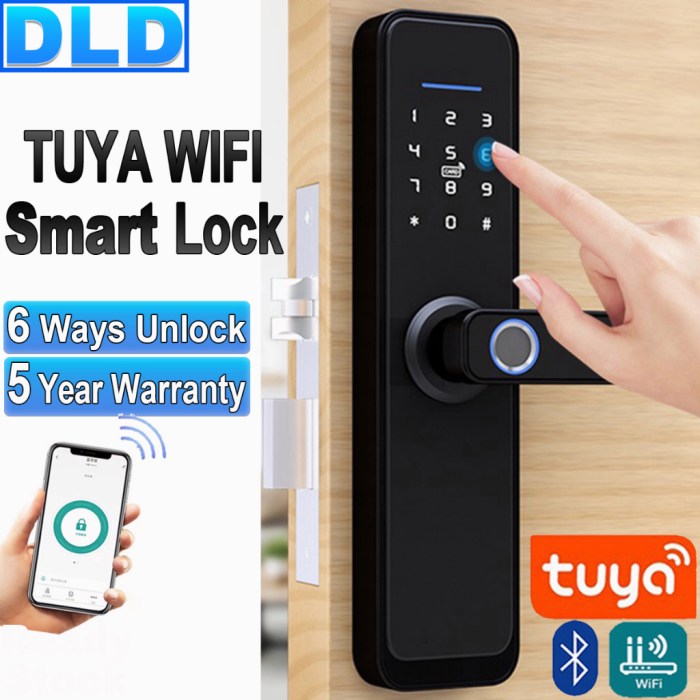
Smart locks, while offering unparalleled convenience and security, require regular maintenance to ensure optimal performance and longevity. Neglecting this can lead to frustrating malfunctions and potential security vulnerabilities. Understanding the basics of smart lock upkeep and troubleshooting common issues is crucial for maximizing your investment and maintaining a secure home environment. This section provides a practical guide to keeping your smart lock running smoothly.
Smart Lock Maintenance Schedule
A proactive approach to maintenance significantly reduces the likelihood of problems. Regular cleaning and software updates are key components of this strategy. Think of it like regular car maintenance; small, consistent efforts prevent major breakdowns. A well-maintained smart lock will provide years of reliable service. The following schedule Artikels recommended practices:
- Monthly Cleaning: Gently wipe the lock’s exterior with a soft, damp cloth. Avoid harsh chemicals or abrasive cleaners, which can damage the finish. Pay particular attention to the keypad or fingerprint sensor, removing any dust or grime that could interfere with functionality. For locks with mechanical components, a light application of silicone lubricant on moving parts can also improve performance.
- Quarterly Inspection: Visually inspect the lock for any signs of damage, loose screws, or unusual wear and tear. Check the battery level and replace batteries as needed. Note the battery life of your specific model; some require more frequent replacements than others. For example, a high-traffic household might need to change batteries every three months, whereas a less frequently used lock might last six months or longer.
- Annual Software Update: Manufacturers regularly release software updates that address bugs, improve security, and add new features. Check your lock’s manufacturer website or app for the latest updates and install them promptly. These updates often contain crucial security patches that protect against vulnerabilities. Failing to update your software can expose your home to security risks.
Common Smart Lock Problems and Solutions, Smart Door Locks
Smart locks, despite their advanced technology, are not immune to occasional malfunctions. Understanding common problems and their solutions empowers you to address issues quickly and effectively, minimizing inconvenience. Here are some frequently encountered problems and their respective solutions:
- Lock Won’t Unlock: First, check the battery level. Low batteries are the most common cause of this issue. Replace the batteries with fresh ones. If the problem persists, try re-pairing the lock with your smartphone app, following the manufacturer’s instructions. If the problem still persists, check for any obstructions preventing the bolt from moving smoothly.
Finally, if all else fails, contact the manufacturer’s customer support for assistance.
- Connectivity Issues: Ensure your smartphone has a strong Wi-Fi or Bluetooth connection. Restart your router and your smartphone. Check that your lock is within the optimal range of your Wi-Fi network. Some smart locks require a specific Wi-Fi frequency; make sure yours is compatible. If the problem continues, try reinstalling the smart lock app on your phone.
Sometimes, app glitches can disrupt connectivity.
- Fingerprint Reader Malfunction: Clean the fingerprint sensor thoroughly with a soft, dry cloth. Ensure your finger is clean and dry before attempting to unlock the lock. If the problem persists, try re-registering your fingerprints in the app. Repeatedly unsuccessful attempts to register might indicate a sensor issue that requires professional attention.
- Keypad Issues: If the keypad is unresponsive or registering incorrect inputs, clean the keypad thoroughly. Inspect the keypad for any physical damage or debris. If the problem is persistent, it might require a replacement keypad, which can usually be purchased from the manufacturer.
Smart Lock Future Trends and Innovations
The landscape of home security is constantly evolving, driven by advancements in technology and a growing demand for seamless, secure access control. Smart locks, already a significant player in this space, are poised for even greater innovation, promising enhanced security, improved user experience, and increased integration with other smart home devices. The future of smart locks is bright, promising a more convenient and secure future for homeowners worldwide.
Emerging technologies are rapidly shaping the future trajectory of smart locks. We can anticipate a convergence of several key areas, resulting in devices that are not only more secure but also more intuitive and adaptable to individual needs. This evolution will redefine how we interact with our homes and enhance the overall security of our living spaces.
Advancements in Biometric Authentication
Biometric technology is already making inroads into smart lock security, but future iterations promise even greater accuracy and sophistication. Imagine a system that uses not only fingerprint scanning, but also advanced facial recognition or even vein pattern recognition for unparalleled security. Such systems would be far more resistant to spoofing attempts compared to current fingerprint scanners, significantly reducing the risk of unauthorized access.
For instance, a system combining facial recognition with a liveness detection algorithm could analyze subtle movements and characteristics to verify the user’s authenticity in real-time, thwarting attempts to use a photograph or video to gain entry.
Enhanced Security Protocols and Encryption
Future smart locks will likely employ more robust encryption protocols and security measures to protect against cyberattacks. Quantum-resistant cryptography, for example, is being actively researched and developed to safeguard against the potential threat of quantum computers breaking current encryption standards. This proactive approach to security will ensure that smart locks remain secure even as computing power increases. Furthermore, we might see an increased reliance on decentralized authentication systems, reducing the risk of single points of failure that are vulnerable to hacking.
Consider a system where authentication is verified across multiple secure nodes, making it significantly more difficult for malicious actors to compromise the system.
Integration with Advanced Smart Home Ecosystems
The integration of smart locks with broader smart home ecosystems will continue to improve. We can expect seamless integration with voice assistants, allowing users to unlock their doors with simple voice commands. Furthermore, more sophisticated automation capabilities will be integrated, allowing for automated locking and unlocking based on location, time of day, or other contextual factors. For example, a smart lock could automatically unlock when a user’s smartphone enters a predetermined geographical zone, and lock automatically upon departure.
This level of integration will transform the user experience, making it more intuitive and convenient.
Innovative Features and Design Improvements
Future smart locks might incorporate innovative features beyond basic access control. For instance, some designs may incorporate integrated cameras for visual verification of visitors, allowing users to remotely see who is at the door before granting access. Other designs might include environmental sensors that can detect things like smoke or carbon monoxide, automatically unlocking the door in emergency situations to allow for quick escape.
The design itself might become more aesthetically pleasing and adaptable to various architectural styles, seamlessly blending into the home’s overall design. Imagine a smart lock that is virtually invisible, seamlessly integrated into the door’s surface.
Conclusion
Ultimately, the shift towards smart door locks represents more than just a technological upgrade; it’s a significant leap forward in home security and convenience. By understanding the various types, security protocols, and integration capabilities, you can transform your home into a secure and effortlessly managed smart space. Remember, consistent maintenance and awareness of potential vulnerabilities are key to reaping the full benefits of this technology.
Embrace the future of home security – one smart lock at a time.
